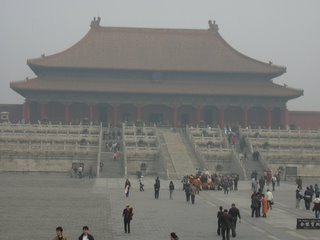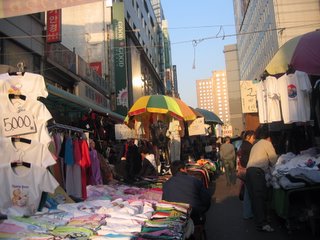
Some people say Beijing is not as exciting as Shanghai or as picturesque as Suchou, but this Chinese capital has its unique attractions too. The Tiananmen Square, which occupies a 44-hectare area, marked several historical events in particular the tragic 1989 Cultural Revolution that killed thousands of students who protested against the ruling communist party. Though it’s more than a decade when I stepped on the ground of the Square, there were some sentiments for the innocent blood shed there.
Then there is the Forbidden City – undergoing renovation works (when I was there last April)for the upcoming Olympics in 2008. It’s beneficial to pay for a guided tour to these attractions as the tour guide would explain the historical background and share other interesting gossips of the places you visit. For example, did you know that there are 9,999 rooms inside the Forbidden City because the number ‘9’ symbolizes power? Or, the colours purple, yellow and red predominate in the Forbidden City because purple symbolizes royalty, yellow for power, and red a symbol of happiness and luck?
 Of course, you must not miss a trip to The Great Wall. This world-famous landmark, also hailed as one of the Seven Wonders of the World, is a true test of one’s fitness and endurance as not everyone could make that tedious climb to the top. But the breathtaking view at the top is well-worth the effort. The best time to visit The Great Wall is spring when it’s not too hot as in summer, too chilling in winter, or too windy in autumn. Still, the wind can get pretty strong up there (your hat may get blown off!). The air also gets very dry the higher you climb. While you are having a great time at these tourist attractions, be alert and look out for pickpockets and pushy touts – which are quite rampant in the tourist areas.
Of course, you must not miss a trip to The Great Wall. This world-famous landmark, also hailed as one of the Seven Wonders of the World, is a true test of one’s fitness and endurance as not everyone could make that tedious climb to the top. But the breathtaking view at the top is well-worth the effort. The best time to visit The Great Wall is spring when it’s not too hot as in summer, too chilling in winter, or too windy in autumn. Still, the wind can get pretty strong up there (your hat may get blown off!). The air also gets very dry the higher you climb. While you are having a great time at these tourist attractions, be alert and look out for pickpockets and pushy touts – which are quite rampant in the tourist areas.Beijing is also a great place for shopping if you know where to go. If you are looking for silk clothing or souvenirs, Silk Street has almost every silk item for anyone. Located not too far from the China World Hotel, the shopping centre sells mainly silk dresses, cloths, accessories and even pearl costume jewellery. But make sure you bargain as the prices are usually marked up.
For those who have a penchant for jades, the Beijing Long Di Jade Carving Factory is one place you might want to drop by. Here, you would get to see how jade is being molded into exquisite jewellery, accessories and antiques. You would also learn how to differentiate between authentic jades from the fakes. Though prices here are fixed, you can try bargaining if you are genuinely interested to buy.
 The ultimate shopping haven is really at Wangfujing Street, where you can grab interesting souvenirs for just S$2. The long stretch of shopping street is fanned by rows of retail shops selling all kinds of assorted souvenirs, clothing, watches, jewellery and food products. Around the corner is the Wangfujing Food Street with many small eateries and restaurants, including McDonald’s and Kentucky Fried Chicken that span two storeys. The Food Street is also where you can try unusual exotic fare like the ‘live’ wriggly bugs I saw in one eatery.
The ultimate shopping haven is really at Wangfujing Street, where you can grab interesting souvenirs for just S$2. The long stretch of shopping street is fanned by rows of retail shops selling all kinds of assorted souvenirs, clothing, watches, jewellery and food products. Around the corner is the Wangfujing Food Street with many small eateries and restaurants, including McDonald’s and Kentucky Fried Chicken that span two storeys. The Food Street is also where you can try unusual exotic fare like the ‘live’ wriggly bugs I saw in one eatery.For those who want to shop in style, there are the bigger departmental stores like the Sun Dong An Plaza and Dong An Department Store, where you can find familiar brands like BreakTalk, StarBucks and Haagen Dazs. The Malls at Oriental Plaza is another huge shopping mall at Wangfujing Street. It houses international brands like Paul Smith, Valentino, Givenchy and Dunhill, for the well-heeled shoppers. It’s no wonder Wangfujing Street is the favourite shopping haunt for both the locals and tourists in Beijing.








